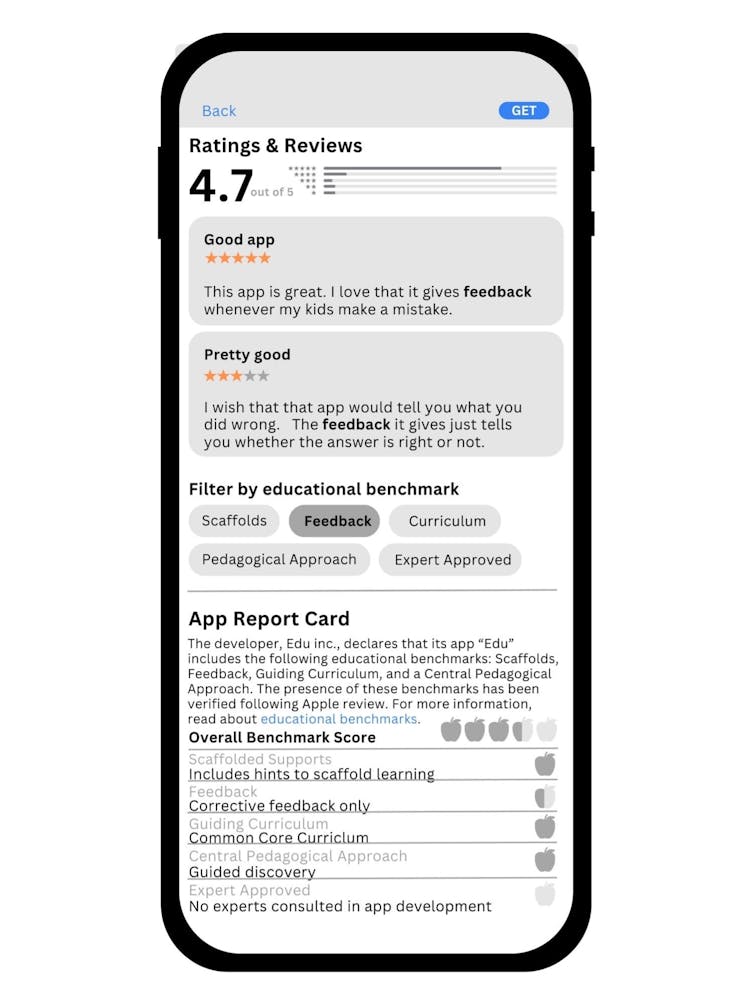Educators and parents buy educational apps (EduApps) to help children learn, bringing in billions of dollars for the mobile app industry, a significant portion of which goes into the pockets of leading app stores.
But when people visit app stores, they are overwhelmed with hundreds of thousands of options. Children can learn from well-designed EduApps, but choosing bad apps wastes schools’ and families’ time and money.
When choosing EduApps, our research from the Technology Learning and Cognition lab at McGill University’s Faculty of Education shows educators and parents rely heavily on others’ judgements, like star ratings.
But app stores are not designed to showcase the information consumers need to judge an app’s educational quality. For example, Apple says it offers “a highly curated App Store where every app is reviewed by experts and an editorial team helps users discover new apps every day,” yet guidelines do not include educational quality standards.
What to ignore
We advise educators and parents to ignore information unrelated to educational quality, like:
1. User ratings & reviews:
Popular EduApps in Apple’s and Google’s app stores typically have very positive ratings (above four stars).
Yet, experts still raise concerns about their quality and expert-approved apps do not necessarily receive the highest star ratings.
Written reviews are rarely more informative. Research shows most reviews simply praise apps rather than explaining specific features.
Even if reviews mention educational aspects, few reviewers have the background to make informed judgements of quality. Anyone can review an app — even children, who like apps that allow them to have fun while they learn but may not know what learning features are necessary to help them learn best.
2. Apple or Google rankings
Educators and parents may visit an app store’s “top charts” lists to find EduApps. Yet, how Apple’s and Google’s algorithms determine which apps “top the charts” is unclear.
Plus, rankings are not related to educational quality, making them unreliable for choosing high-quality apps.
3. Recommendations from app review websites
Educators and parents might look to external app review websites like Common Sense Media for recommendations. But research shows many of the apps recommended by these websites still need substantial improvement — and only a fraction of apps get reviewed. Avoid relying only on recommendations from these websites.
(Emma Liptrot/Adam Kenneth Dubé)
What to look for
We propose looking for five educational benchmarks of quality that can be found in an app’s written description, where developers describe the app and its features.
1. Curriculum: What apps teach
At the bare minimum, EduApps must include content that is covered in an established learning program. Yet, many EduApps are what researchers call “educational misfits” because they are only weakly related to education, if at all. Look for apps that clearly state which curriculum their content is based on (for example, a particular provincial curriculum, a supplemental curriculum for learning an Indigenous language) or detail the content (suitable for grades 1–3 math). Don’t bother with an app that doesn’t tell you what it covers.
2. Learning theory: How apps teach
An app developer’s ideas about learning — their learning theory — impacts what tasks children are asked to do and what kinds of learning can happen. An app that uses repetition to help children memorize facts promotes different learning outcomes and meets different needs than an app that encourages experimentation and discovery. Look for apps that describe how they teach. Choose ones using approaches that align with your needs.
If an app doesn’t tell you how it helps children learn, it’s not worth your time.
3. Scaffolding: How apps support learning
EduApps should include supports that help children build their understanding and accomplish learning goals. These supports (called scaffolding) can include hints or instructions when children get stuck and breaking down complex tasks into smaller chunks or adapting difficulty to match children’s abilities. Look for apps with supports that help guide and structure children’s learning.
4. Feedback: How apps correct learning
If we want children to learn from their mistakes, feedback is essential. Look for apps that give children informative feedback so they know where they went wrong and why.
5. Educational expertise: Who made the app
Many app developers are not education experts, and their priorities may not align with those of educators and parents. Look for apps that consult educational experts like teachers or researchers so they are designed with children’s learning needs and abilities in mind.
Other considerations
Our five educational benchmarks focus on the potential educational value of apps. However, other considerations related to children’s safety are also important, like how apps manage children’s privacy and data and how children are exposed to advertising.
Read more:
Why freemium software has no place in our classrooms
Working together to choose better apps
The current state of app stores makes finding a good EduApp like searching for a drop in the ocean. To aid their search, educators and parents can look for educational benchmarks, and watch our video on YouTube, “How to find an educational app.”
We conducted research that showed this helped parents identify quality educational apps via the benchmarks discussed above.
Finding a good EduApp shouldn’t be so hard. These profitable app stores have a duty to help ensure families’ and schools’ resources are not wasted on bad apps.
We call on Apple and Google to redesign their app stores to bring educational benchmarks to the surface.

(Liptrot and colleagues)
Such a redesign would make it easier to find good apps among a sea of possibilities.
With so many apps available, app store owners, researchers, educators and parents must work together to get the best EduApps into kids’ hands.




